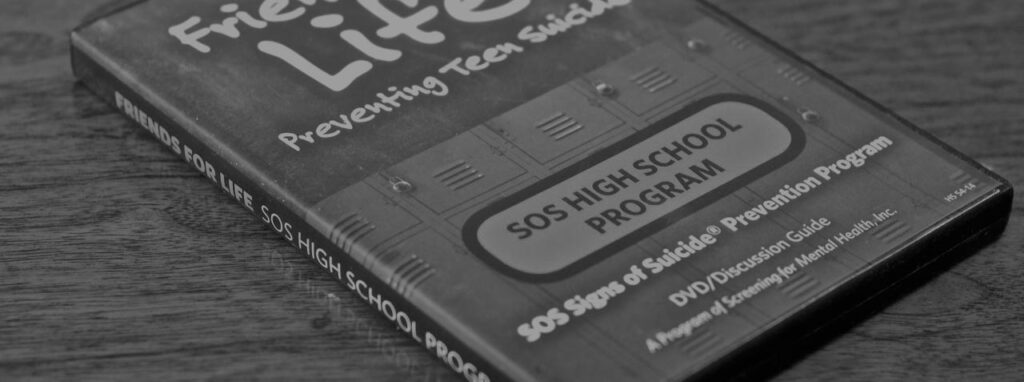 Screening for Mental Health, Inc.
×
Screening for Mental Health, Inc.
×

PREVENTION & EDUCATION
Effective suicide prevention requires addressing multiple levels of influence on youth mental health. The SOS program employs a public health approach recognizing that suicide results from complex interactions between individual, relationship, community, and societal factors. Prevention strategies must therefore target these multiple levels simultaneously to achieve meaningful impact.
Primary prevention focuses on reducing risk factors and strengthening protective factors before suicidal thoughts or behaviors emerge. The SOS program emphasizes universal education ensuring all students receive information about mental health, depression, and suicide. This foundation-level prevention reduces stigma, increases mental health literacy, and normalizes help-seeking behaviors across entire student populations.
Secondary prevention involves early identification of at-risk individuals and prompt intervention before situations escalate. Screening components of the SOS program identify students experiencing depression or other risk factors, enabling timely connection with appropriate support services. This early intervention approach prevents progression from suicidal thoughts to suicide attempts.
Tertiary prevention supports individuals who have already experienced suicidal crises, preventing future attempts and promoting recovery. While the SOS program primarily targets primary and secondary prevention, its protocols include provisions for supporting students after crisis events, ensuring comprehensive prevention across all stages.
Education represents the cornerstone of SOS prevention strategies. When students understand mental health conditions, recognize warning signs, and know how to access help, they become active participants in prevention rather than passive recipients of services.
The SOS curriculum teaches students that mental health conditions including depression are medical illnesses, not character flaws or signs of weakness. This reframing reduces self-stigma among struggling students while encouraging compassionate responses from peers. Students learn that depression and suicidal thoughts result from brain chemistry changes, traumatic experiences, genetic factors, and other causes beyond individual control.
Understanding causation helps students recognize that mental health conditions are treatable. The curriculum emphasizes treatment effectiveness, sharing statistics about recovery rates and highlighting various treatment options including therapy, medication, lifestyle changes, and support systems. This hopeful message counteracts feelings of helplessness that often accompany depression and suicidal ideation.Warning signs education equips students to recognize indicators of suicide risk in themselves and peers. The SOS program teaches specific behavioral, emotional, and verbal warning signs including talking about wanting to die, expressing feelings of hopelessness, withdrawing from friends and activities, giving away possessions, increased substance use, and dramatic mood changes. Students learn that multiple warning signs appearing together warrant serious concern and immediate action.
PROMOTIONS & SUPPORT
The ACT framework provides students with a clear, actionable response protocol when they encounter warning signs. This simple yet powerful tool translates knowledge into life-saving action.
Acknowledge teaches students to take warning signs seriously rather than dismissing them as attention-seeking or temporary mood changes. Students learn that acknowledging someone’s pain and suicidal thoughts does not increase suicide risk. Instead, acknowledgment often provides relief and opens pathways to help. The program dispels myths that talking about suicide causes suicidal behavior, empowering students to have difficult but necessary conversations.
Care emphasizes showing compassion and support to individuals experiencing suicidal thoughts. Students learn basic supportive communication skills including active listening, expressing concern without judgment, and offering presence during difficult times. The care component recognizes that human connection and compassion represent powerful protective factors against suicide.
Tell instructs students to inform responsible adults about concerning situations. The program identifies appropriate adults including parents, school counselors, teachers, coaches, and other trusted authority figures. Students learn that telling is not betraying a friend’s confidence but rather taking responsible action to protect someone’s life. The SOS program reframes telling as an act of caring and courage rather than tattling.
Prevention extends beyond individual education to creating school cultures that support mental health and encourage help-seeking. The SOS program catalyzes broader environmental changes within schools.
Reducing stigma occurs when schools openly discuss mental health through SOS implementation. When entire student bodies receive consistent messages normalizing mental health challenges and treatment, stigma diminishes. Students become more comfortable disclosing struggles and seeking support when they understand mental health conditions are common and manageable.
Increasing help-seeking behaviors represents a measurable outcome of SOS implementation. Research demonstrates that students participating in the program show greater likelihood of seeking help for themselves or encouraging peers to access support. This cultural shift toward proactive help-seeking creates environments where students intervene early rather than suffering in silence.Training gatekeepers throughout the school community multiplies prevention capacity. Teachers, counselors, coaches, administrators, and support staff trained through SOS implementation become knowledgeable observers capable of recognizing warning signs and responding appropriately. This network of aware adults creates safety nets catching students who might otherwise fall through cracks.

RISK MANAGEMENT & LIABILITY
The screening component of SOS functions as a critical prevention strategy identifying at-risk students who might not self-disclose. Universal screening normalizes mental health assessment while catching students who successfully mask their struggles from peers and adults.
Brief screening instruments assess depression symptoms and suicide risk factors efficiently without disrupting instructional time significantly. Validated tools ensure accuracy while maintaining age-appropriate language and content. Students complete screenings confidentially, reducing concerns about peer judgment that might otherwise prevent honest responses.
Follow-up protocols transform screening data into prevention action. School mental health professionals review results, contact students showing elevated risk, conduct more comprehensive assessments, and coordinate appropriate interventions. This systematic approach ensures no at-risk student goes unnoticed or unsupported.
Effective prevention extends beyond school walls to include families as partners. The SOS program encourages parent education about youth suicide, warning signs, and communication strategies. When parents understand mental health and suicide prevention, they become more effective supporters and more likely to seek help for struggling children.
Communication between schools and families following screening creates coordinated support systems. Parent notification protocols balance student privacy with family involvement, ensuring appropriate information sharing that protects student wellbeing while respecting confidentiality.
Research on SOS prevention outcomes demonstrates sustained positive effects. Studies show reduced suicide attempts, increased knowledge about depression and suicide, improved attitudes toward mental health treatment, and greater help-seeking behaviors persisting months after program participation.
These outcomes validate the SOS prevention framework as an effective approach to reducing youth suicide. By combining education, screening, clear intervention protocols, and environmental change, the program addresses suicide prevention comprehensively rather than relying on single-strategy approaches with limited effectiveness.
The SOS Signs of Suicide prevention framework recognizes that protecting youth mental health requires collective effort. When schools implement comprehensive prevention programs, train gatekeepers, educate students, screen for risk factors, and create supportive environments, they fulfill fundamental responsibilities to student safety and wellbeing.
Prevention saves lives while building healthier communities where young people flourish. Through evidence-based programs like SOS, schools become powerful forces for suicide prevention, transforming education systems into protectors of both academic achievement and mental health.

FEATURED PROGRAMS
SOS Second Act is designed to build resiliency in young adults. In addition to reviewing the signs and symptoms of depression and suicidality, students are prompted to discuss substance abuse and other risky behaviors. Students are provided with a solid foundation on health care basics, health insurance, and self-care tips on seeking mental health treatment in the “real world.”
The Online Parent Brief Screen for Adolescent Depression (BSAD) allows parents to assess their child for suicide or depression risk factors. After parents complete a series of questions online, the screening provides results, local referral options (determined by each school), and relevant, educational information.